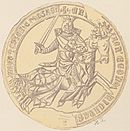Eric II of Norway facts for kids
Quick facts for kids Eric II Magnusson |
|
|---|---|

Contemporary bust of Eric II from the Stavanger Cathedral, dated to the 1280s.
|
|
| King of Norway | |
| Reign | 9 May 1280 – 15 July 1299 (rex iunior from 1273) |
| Coronation | 1280, Old cathedral of Bergen |
| Predecessor | Magnus VI |
| Successor | Haakon V |
| Born | 1268 |
| Died | 15 July 1299 Bergen |
| Burial | Old cathedral of Bergen |
| Consort | Margaret of Scotland Isabel Bruce |
| Issue | Margaret, Queen of Scots Ingeborg, Duchess of Finland |
| House | Sverre |
| Father | Magnus VI of Norway |
| Mother | Ingeborg of Denmark |
| Religion | Roman Catholic |
Eric Magnusson (born 1268 – died 15 July 1299) was the King of Norway from 1280 until 1299. In Old Norse, his name was Eiríkr Magnússon. In Norwegian, it is Eirik Magnusson.
Becoming King of Norway
Eric was the oldest living son of King Magnus the Lawmender of Norway. His mother was Ingeborg Eriksdatter, who was the daughter of King Eric IV of Denmark.
When Eric was only five years old, in 1273, he was given the title of king. His father, King Magnus, planned for Eric to rule alongside him. However, King Magnus died in 1280 before this could happen.
After his father's death, Eric became the sole king. He was crowned in Bergen in the summer of 1280. Because Eric was still young, a group of important noblemen helped him rule the kingdom. His mother, Queen Ingeborg, likely also played a big part.
Even after Eric became an adult in 1282, this royal council still had a lot of influence. Eric's younger brother, Haakon, was given the title "Duke of Norway" in 1273. From 1280, Haakon ruled a large area around Oslo and Stavanger. He was under the authority of King Eric. King Eric's main home was in Bergen, in Western Norway.
Eric's Marriages and Family
King Eric married Princess Margaret of Scotland in Bergen in 1281. She was the daughter of King Alexander III of Scotland. Sadly, Margaret died just two years later, in 1283, while giving birth.
Their daughter was named Margaret, Maid of Norway. She was meant to become the Queen of Scotland. However, she died in 1290 when she was still a child. Her death caused a big disagreement over who should rule Scotland. This eventually led to the Wars of Scottish Independence. For a short time, King Eric tried to claim the Scottish crown for himself, as his daughter's heir, but he was not successful.
Later, Eric married Isabel Bruce. She was the sister of King Robert I of Scotland. Eric and Isabel did not have any sons who lived to adulthood. They did have a daughter named Ingeborg Eriksdottir of Norway. In 1312, Ingeborg married Valdemar Magnusson of Sweden, who was the Duke of Finland.
King Eric's Reign
A major part of Eric's time as king was a war with Denmark. This war was called the War of the Outlaws. It happened on and off from 1289 to 1295. One main reason for this war was Eric's claim to land in Denmark that belonged to his mother's family.
In 1287, Eric made an alliance with some Danish nobles. These nobles, like Jacob Nielsen, Count of Halland and Stig Andersen Hvide, were declared outlaws in Denmark. They were accused of killing the Danish king Eric V. King Eric gave these outlaws a safe place in Norway in 1287.
King Eric himself led a large Norwegian fleet. Along with the Danish outlaws, they attacked Denmark in 1289. They burned the town of Elsinore and threatened Copenhagen. More naval attacks on Denmark happened in 1290 and 1293. Finally, peace was made in 1295.
King Eric was sometimes called "Priest Hater." This was because he had difficulties in his relationships with the church leaders.
Eric died without any sons. So, his brother, Haakon, became the next king, known as Haakon V of Norway. Eric was buried in the old cathedral in Bergen. This cathedral was later torn down in 1531. Today, a memorial marks its location at the Bergenhus Fortress.
See also
 In Spanish: Erico II de Noruega para niños
In Spanish: Erico II de Noruega para niños



